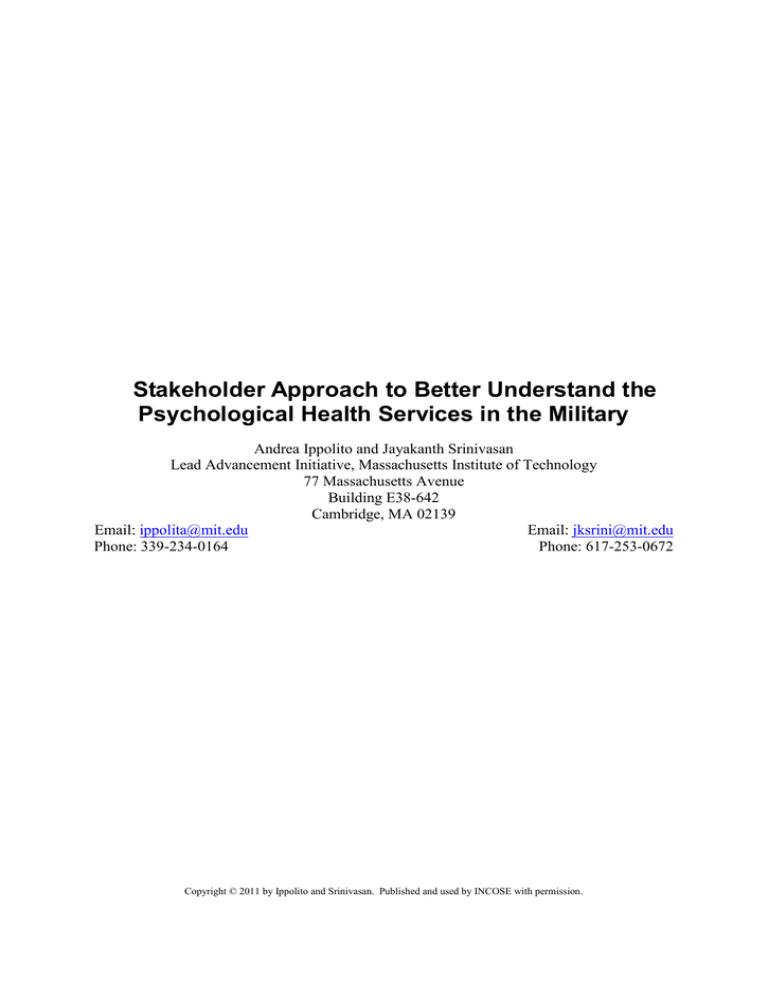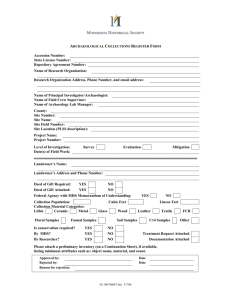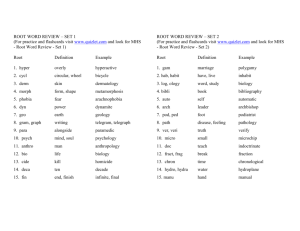Stakeholder Approach to Better Understand the
advertisement

Stakeholder Approach to Better Understand the Psychological Health Services in the Military Andrea Ippolito and Jayakanth Srinivasan Lead Advancement Initiative, Massachusetts Institute of Technology 77 Massachusetts Avenue Building E38-642 Cambridge, MA 02139 Email: ippolita@mit.edu Email: jksrini@mit.edu Phone: 339-234-0164 Phone: 617-253-0672 Copyright © 2011 by Ippolito and Srinivasan. Published and used by INCOSE with permission. Abstract. Ensuring the psychological well-being of service members and their families has emerged as one of the principal challenges of today‟s armed services. Given that the system of care of psychological health services in the United States Military cannot be divorced from the large healthcare delivery system, an enterprise perspective is needed to truly understand the dynamics of the system of care. This paper makes two key contributions: it identifies the key stakeholders of the military health enterprise with respect to psychological health, and analyzes the espoused senior leadership values over the last decade as seen in the stakeholder reports. This stakeholder analysis highlights the challenges faced in melding the constituent organizations into an enterprise, especially in the face of leadership turnover. The thematic analysis of senior leadership values shows an evolution of focus from managing execution of care to a more holistic emphasis on healthy lifestyles and psychological health. Background Since October 2001, approximately 1.64 million U.S. troops have been deployed as part of Operation Enduring Freedom (OEF; Afghanistan) and Operation Iraqi Freedom (OIF; Iraq). The current pace of deployments in both OEF and OIF is unprecedented in the history of the all-volunteer force (Belasco, 2007; Bruner, 2006). In addition, the length of the deployments in OEF and OIF has been longer, redeployments have been more frequent, and breaks between deployments have been shorter. (Hosek, Kavanagh, and Miller, 2006). Developments in medical technology and body armor are enabling more servicemembers to survive – the casualty rates of killed or wounded are lower than in previous wars, such as Vietnam and Korea. (Regan, 2004; Warden, 2006). More servicemembers are surviving war experiences that would have led to death in previous wars, resulting in the further emergence of “invisible wounds” such as mental health conditions and cognitive disorders. The three major disorders of the wars cited in the recent Rand report (Tanielian and Jaycox, 2008) are Post Traumatic Stress Disorder (PTSD; 5-15% prevalence), Major Depression Disorder (MDD; 2-14% prevalence), and Mild Traumatic Brain Injury (TBI; 2-6% prevalence). The Military Health System (MHS) provides psychological health services as part of the larger health care delivery system serving Uniformed Service members, retirees and their families worldwide. The care in garrison is provided by Military Treatment Facilities (MTFs) and further augmented with purchased care from civilian providers that is managed through the TRICARE program. “In Theatre” care is provided by the medical commands of the services in the forward operating bases treatment facilities. To date, over $2 billion has been invested in providing psychological health services, and the FY 2010 budget allocation for psychological health totaled $715 million with over 125 psychological health programs distributed throughout the military. This action was triggered by the DoD Task Force on Mental Health report that noted that the current system of care was insufficient to meet the current and future needs of service members and their beneficiaries (DoD Task Force on Mental Health, 2007). Problem Statement Despite this large allocation of resources and seemingly extensive support network, there are still several challenges currently facing the MHS enterprise. Given that the prevalence of PTSD and major depression will likely remain high unless greater efforts are made to enhance systems of care, four enterprise-wide challenges need to be addressed: Access to and quality of care; Culture and stigma associated with psychological health disorders; Consideration of families in treatment; Disconnect on who within the MHS enterprise provides care to those affected by psychological health disorders. With regard to access, Tanielian and Jaycox (2008) found that only about half of service members faced with PTSD and MDD seek and receive help from a physician or mental health provider and more than half of probable TBI patients have never seen a doctor. Along with problems accessing care, quality of care has shown to be an issue. For instance, only about 60% of PTSD and MDD patients that sought help receive evidencebased care. In addition, the effectiveness of TBI treatments is currently unknown and relies heavily on expert judgment. Often times, drug therapies have unpleasant side effects and it was reported that “good mental healthcare was not very effective.” The second challenge faced by the MHS is the culture and stigma surrounding psychological health disorders. The stigma associated with these conditions is three-fold (Tanielian and Jaycox, 2008): personal (perception of individual weakness, internalized social perspective), public (misperceptions of the term “disorder”, especially related to psychological health), and institutional (unreasonable policies and procedures often make access to care for psychological health difficult, time-consuming, and delayed). One example of this last case is that care is often only available during “duty hours” forcing service members to seek help when they are supposed to be working. In addition, there are concerns that treatment would not be kept confidential and would limit future job assignments and military advancement for affected servicemembers. Thirdly, families are often times not considered in the treatment of mental health disorders, even though they are frequently exposed to the repercussions of the disorders when service members return home. These conditions remain unnoticeable to most in the public, but certain symptoms, such as emotional numbing and anger, dramatically impact family relationships. (Ray and Vanstone, 2009) These mental health disorders dramatically affect mood, thoughts, and behavior. It is important to include support and training for the family of servicemembers diagnosed with psychological health disorders; however they are often times neglected. Finally, there is a fundamental disconnect on who within the MHS enterprise provides care to those affected by psychological health disorders. Until recently, there was limited infrastructure in place to treat mental health disorders. As shown by the challenges described above, the challenges facing psychological health span the full spectrum of care of the soldier with regard to preparation, resilience, training, and reintegration. We must consider the technological, social, and organizational factors involved within the enterprise of psychological health services. In other words, a holistic approach is needed to further understand the key stakeholders of the enterprise, and the architecture of value exchange within the enterprise. This paper is a first step at articulating the architecture of the value exchange in the psychological health enterprise by identifying its key stakeholders. Given that the leadership of enterprise significantly influences the effectiveness of value exchange, we extract their espoused values through a longitudinal analysis of the published stakeholder reports. Stakeholder Analysis The notion that actively managing stakeholders was an integral part of successfully managing an organization was first introduced by Freeman (1984), who stated that, “the stakeholder approach is about groups or individuals who can affect the organization, and is about managerial behavior taken in response to those groups or individuals.” Stakeholder analysis provides us with an opportunity to assess the value exchange between stakeholder groups and align the enterprise with its stakeholders. By further understanding the stakeholders within the system and their core values, we can evaluate the ability of MHS to connect their stakeholders to their current value proposition, recognize any misalignments, and propose necessary corrective action. Figure 1. Waterdrop Model of Stakeholders with the MHS Enterprise Psychological Health Services Enterprise. The key stakeholders groups within the psychological health realm of the MHS enterprise are depicted below in Figure 1. This “waterdrop model” shows the current relationships between the stakeholders within the enterprise. As defined by Nightingale and Srinivasan (2011), an enterprise is “a complex entity with a specific purpose, which is to fulfill its value proposition – that is, its reason for being…An enterprise has distributed leadership and diverse stakeholders who share some interests in common.” By looking at the MHS as an enterprise composed of diverse stakeholder groups, we can assess the current state of the continuum of care for psychological health services. As shown in Figure 1 above, there are two large clusters: one is revolving around the MHS leadership/organization, while the second is revolving around the execution of care surrounding the warrior. It is important to point out that while the actual provision of care happens at the execution layer, the policies, guidance and resources are provided by the leadership level. Throughout this paper, we will address these “layers‟ within the MHS enterprise. Our goal is to analyze how effective the MHS enterprise is in providing value to each of its stakeholders. As defined in the Lean Enterprise Value, value is “how various stakeholders find particular worth, utility, benefit, or reward in exchange for their respective contributions to the enterprise.” Specifically, we will focus on the values espoused (as captured in documentation) of the leaders within the MHS enterprise because leadership drives policy change and dramatically influences transformation efforts. It is critical to secure leadership commitment to drive and institutionalize enterprise behaviors. In addition, within the architecture of the Military Health System, there are 7 „views‟ to analyze the enterprise: strategy, process, information, knowledge, service, policy, and organizational views. Specifically, we will focus on the organizational view, which represents organizational structure of the enterprise, as well as relationships, culture, behaviors, and boundaries between individuals, teams and organizations. This will help us understand the impact of the decisions made by MHS leaders on the system of care surrounding behavioral health. Therefore, the focus of this paper will be to understand the current MHS leadership organization and the values of each of the leaders within this enterprise, so that we can best understand how to architect the future state of psychological health services provided within the MHS enterprise. MHS Leadership Stakeholder Analysis The MHS is structured as a hierarchy as shown in Figure 2. Formally, MHS is governed through the Military Health System Executive Review (MHSER), which is chaired by the Under Secretary of Defense (Personnel & Readiness). This review board is the advisory body for the MHS, which has been charged to focus on “representing the stakeholder perspective.” (MHS Policy for Decision Making, 2006). The Senior Military Medical Advisory Council (SMMAC) focuses on the recommendations provided by the MHSER and is the decision-making authority of the MHS. They monitor progress on the key strategic and operations milestones within the MHS enterprise. Please see Table 2 for the members within each of these councils. Another important organization to note is the Office of Transformation (OT), which is a jointly staffed office under the authority of the Under Secretary of Defense for Personnel & Readiness. This Office is responsible for providing oversight and management in the execution of “transforming” the medical force, infrastructure, business operating model, and TRICARE benefit of the MHS enterprise to execute the Quadrennial Defense Review (QDR), which is mandated by Congress every four years. Several disconnects exist across the leadership of the MHS enterprise. For instance, the Director of the OT can provide recommendations to the MHSER as a non-voting member, but can only serve as an attendee within the SMMAC organization despite their heavy responsibilities involved with implementing several key reviews of the MHS enterprise. (This problem is further exacerbated by the fact that the Director of the OT position remains unfilled.) In addition, although the Surgeon Generals (SG) of the services (Army, Navy, and Air Force) serve on the SMMAC under the ASD(HA), they are technically the decision-making authority within their individual service. This results in large variations with the execution of military health programs across the services as they often work in siloes and do not collaborate on similar initiatives. Within the MHS, there seems to be a strong disconnect between who sets the policy and who implements it. This “two phase” approach within the MHS enterprise is a key trend across the leadership organization, which may help demonstrate why many emerging problem areas, such as psychological health, often are not treated properly due to miscommunication between the “policy-makers” and “policy implementers.” Figure 2. Organizational Structure within the MHS Enterprise (from MHS Policy for Decision Making). As chair of SMMAC and a member of MHSER, the ASD(HA) is the senior health policy-making official in the DoD and is responsible for the key issues set by both the MHSER and SMMAC. To lead these policy implementations, the ASD(HA) oversees the efforts of the seven Deputy Assistant Secretaries of Defense (Health Affairs) (DASDs(HA)), which are listed in Table 2 below. The DASDs are the primary policy coordinators and advocacy leaders in their specific areas for health policy-decision making and are also expected to monitor implementation. We outline the responsibilities of the DASDs below (as stated in the 2007 policy directive) to highlight the disconnect between MHS DASD leadership and the services. The ASD(HA) does not specifically hold the DASDs responsible for deploying policy changes across the services. Technically, each DASD (excluding the Chief of Staff) is responsible for a Functional Integration Council (FIC). These FICs were created to ensure that issues developed are coordinated across the services and functional areas. Under each FIC, several working groups, Integrated Project Teams (IPTs), committees (described as “groups” in Figure 2), exist to provide recommendations and advice back to the ASD(HA). Although these councils are supposed to integrate personnel across all the services (Army, Navy, Air Force), service involvement within these groups is only voluntary leading to little motivation of members of the service to involve themselves. Table 1. Members of both the MHSER and SMMAC (from MHS Policy for Decision-Making) Decision-Making Authorities Voting Members MHSER Under Secretary of Defense (USD) Personnel & Readiness (P&R), Principal Deputy (PD) USD P&R, PDUSD Comptroller, ASD (HA), Assistant Secretary (AS) of the Army (Manpower & Reserve Affairs (M&RA), AS of the Navy (M&RA), AS of the Air Force (M&RA), Vice Chief of Staff US Army, Vice Chief of Naval Operations, Vice Chief of Staff US Air Force, Assistant Commandment of the Marine Corps, Director Joint Staff, Director Program Analysis & Evaluation SMMAC ASD (HA), SG US Army, SG US Navy, SG US Air Force, Joint Staff Surgeon, PDASD (HA), C&PP, FHP&R, CFO, CIO, TMA As described earlier, this highlights this disconnect between the policy-makers and policy implementators across the services. Also, based on the last available MHS Policy for Decision-Making, which was last published in 2006, they listed a total of 83 IPTs, working groups, and committees across the MHS enterprise. Despite this extensive listing of focus areas, there was not one group that was charged with providing recommendations to the ASD(HA) surrounding psychological health. In order to understand this gap in policy efforts devoted to psychological health services, we will take a closer look at the core values of the MHS leadership. Table 2. Roles and Responsibilities of the ASD (HA) and DASDs (from MHS Policy for Decision-Making) Ownership Roles ASD (HA) Responsibilities Senior health policy-making official in the DoD SMMAC Chair PDASD (HA) Maintain the portfolio for external relationships with Congress, Office of Mgmt and Budget, Centers for Medicare & Medicaid, beneficiary organizations, and the media CIO DASD Advises on matters related to information management (IM), enterprise standards & architecture, and performance measurements Share technologies with VA & other agencies CFO DASD Advises on health financing policy, strategy for DoD health budgets and programs, and monitoring performance review FHP&R DASD Advises on all DoD deployment medicine and force health protection and readiness policies, programs, and activities TMA DASD Serves as the TRICARE Program Manager for TRICARE health and medical resources Serves under the Director of TMA C&PP DASD Advises and formulates policy on Clinical Quality and Patient Safety in the MHS DASD Chief of Staff Principal Integrator for all Activities under the ASD (HA) and integration within the Office of the USD (P&R) MHS Leadership Values As mentioned earlier, a critical component of stakeholder analysis is to understand stakeholder values. To further understand the values of leaders within MHS, we conducted an analysis of the past ten years of stakeholder reports generated by the MHS. We choose to primarily focus on these reports because they were the most consistent documentation from the past decade recording MHS leader‟s values, goals and objectives over time. Ideally, a stakeholder report chronicles information and value statements of the various stakeholder groups to give the reader a “pulse” on the current state of the key actors within an enterprise. In general, many of these reports fell short in describing all of the stakeholders within the MHS, often times focused only on the opinions of the leaders and metrics surrounding the TRICARE health plan. In addition, several other gaps exist across the report, including the lack of a report in 2009 and the missing perspectives of the Surgeon Generals of the Army, Navy, and Air Force from 2001 to 2003. Also the reports highlight the frequency of leadership changes across the MHS organization. Since 2001, six individuals have held the title of ASD(HA) with four individuals holding the title in the last 3 years alone. The Surgeon Generals appeared to have turned over every 2-3 years within each of the services. To properly identify MHS leadership values, we first looked at the frequency of psychological health references in each of the MHS leaders‟ statements from the stakeholder reports from 2001 - 2010 (see Figure 3 below). We examined the number of “meaningful references” of psychological health by the MHS leaders. (To calculate this, we looked at the specific context of the reference and not just word counts.) By looking at these references, we were able to identify several discrepancies between the messages related to pyschological health provided by the ASD(HA) and surgeon generals across the report. For instance, the ASD(HA) placed a heavy emphasis on the importance of addressing mental health disorders in the military in 2007, but not one of the SG of the services made any reference to it. In contrast, the Surgeon Generals of the Army, Air Force, and Navy described the importance of providing care for those suffering from mental health disorders in 2010, but the ASD(HA) failed to mention this issue in their statement. Earlier, we described gaps between the development vs. execution of policy within MHS, while this examination of psych health references highlights the disconnect between communications directly within the leadership of the MHS Enterprise. Figure 3. Psychological Health References described in the MHS Stakeholder Reports from 2001 – 2010. After identifying the references to psychological health in the Stakeholder Reports, we teased out the specific values of each of the MHS leaders. As shown in Tables 3, we have listed out the number of values described by each MHS leader and the number of values related to mental health. Up until 2007, we found limited data where leaders discussed psychological health as a priority despite the growing numbers of servicemembers returning home from OEF and OIF with mental health needs. Psychological health was not even mentioned in the body of any of the stakeholder reports until 2006. In this 2006 report, one of the sections described the current state, implications, and programs available to support treatment of combat stress in extensive detail. However, none of the MHS leaders even mentioned psychological health in their statements. As discussed in the previous section, this “two phase” approach of organizing MHS, which separates the policy-makers vs. the policy-implementers, often leads to a disconnect between what leaders‟ value and what is actually taking place across the organization. The value statements of the leaders should reflect the key strategic execution areas of MHS. SG (Air Force) SG (Navy) SG (Army) ASD(HA) Table 3. Value references of the ASD(HA) within the 2001 – 2010 MHS Stakeholder reports. VC 2001 2002 2003 2004 2005 2006 2007 2008 2010 Total 9 13 16 8 16 16 15 8 5 PH 0 0 0 0 0 0 3 1 0 Total 2 2 6 4 9 14 PH 0 0 0 0 1 3 Total 3 4 11 5 11 9 PH 0 0 0 0 1 0 Total 11 8 9 10 9 7 PH 0 0 0 0 0 1 VC: Count of Values Espoused by Senior Leadership PH: Count of Values Related to Psychological Health We took a closer look at the values presented by each of the MHS leaders and we found some common trends across the leadership statements. From 2002-2007, Dr. William Winkenwerder held the position of ASD(HA) (see Figure 4 below). Earlier in his term, most of his values were surrounding the management of TRICARE and disemminating medical entitlements to the appropriate beneficiaries. In 2005, there was a shift: most of his value statements seemed to revolve around providing care and service to promote healthy lifestyles. These values were also reflected in several of the leader‟s values. For instance, the Surgeon Generals of the Army, Navy, and Air Force all spoke extensively about the importance of fostering healthy lifestyles for both servicemembers and their families. In this same year, the report actually discussed the importance of the various the stakeholders within the MHS organization. For instance, the last page of the report states “ What We Value and Why It Matters: When employees are valued, they find satisfaction within their jobs and deliver better customer service resulting in happier beneficiaries. Appreciated employees have a positive impact on the success of an organization. Within the Military Health System, we place a high value on our personnel. This value has a direct effect on how we deliver the TRICARE health benefit.” This was one of the first times that the different stakeholders within the MHS organization were taken into consideration. In this same year, each of the leader‟s values statements also seemed focused on the entire system by describing values surrouding transformation across the MHS, VA-DOD collaborations, and the delivery of care to promote healthy lifestyles. In the following years, many of the leaders‟ values also reflected this change in approach: they then began to look at treating the “whole patient,” which included identifying psychological health as a priority in 2007. Figure 4. Trends Surrounding MHS Leadership Values From 2007 – 2010, the ASD(HA) and surgeon generals all mentioned the importance of mental health resiliency, reducing stigma, and treatment of TBI. In addition, the discussion of values associated with psychological health aligned with the creation of the Defense Center of Excellence for Psychological Health and Traumatic Brain Injury (DCoE) in 2007. Although they all discussed values associated with psychological health, there seemed to be limited coordination in their statements in 2007, 2008, and 2010 (no report in 2009), which could potentially be due to fact that the position of the ASD(HA) changed 5 times from 2007 to 2010. To further understand how psychological health treatment programs are executed currently, we will take a closer look at the DCoE in the following section. Role of the Defense Center of Excellence for Psychological Health and Traumatic Brain Injury Under the National Defense Authorization Act of 2007, Congress mandated the creation of the Defense Center of Excellence for Psychological Health and Traumatic Brain Injury (DCoE). The DCoE was established to provide clinical guidance and share best practices with treating psychological health and TBI across the services. The formation of the DCoE was heavily influenced by the increasing rates of deployments of troops to Iraq and Afghanistan, along with several reports that highlighted the immediate need to provided expanded health services for servicemembers, specifically services for psychological health and TBI (Defense Centers of Excellence for Psychological Health and Traumatic Brain Injury: Annual Report 2009). Prior to the DCoE, four separate centers were already in place to help treat and understand psychological health and TBI, which included the Center for Deployment Psychology (CDP), Center for the Study of Traumatic Stress (CSTS), Defense and Veterans Brain Injury Center (DVBIC), and the Deployment Health Clinical Center (DHCC). Each of these centers was brought together to coordinate their efforts under the DCoE. Two additional centers, the National Center for Telehealth & Technology (T2) and the National Intrepid Center of Excellence (NiCOE), were developed under the DCoE umbrella to complement the current efforts of the existing centers. The DCoE Director, previously held by Brigadier General Lori Sutton, serves as a special assistant to the ASD (HA). Although the DCoE has a direct link to the MHS Leadership, it is still unclear how the DCoE is connected to the services. For instance, the DCoE focuses its efforts are performing research to further understand how to diagnose & treat PTSD. However there is limited infrastructure in place to disseminate this information to service providers both with and outside of the MHS enterprise. In particular, there is no formal mechanism in place even to relay this information to the individual services, such as the Army, Navy, and Air Force. (In addition, none of the leaders even addressed the importance of providing psychological health services to the reserve units). Again, this highlights the discrepancy between those setting the policy and those implementing it. Future Work and Conclusions Overall, there is a strong disconnect between the leadership within the MHS enterprise and their ability to execute consistently on tasks associated with psychological health disorders. The current structure of MHS leadership has only recently begun to understand and value the importance of providing treatments to servicemembers surrounding psychological health. Despite the creation of the DCoE in 2007, the leadership is yet to develop the infrastructure to provide quality and accessible psychological health treatments to the services. We would like to take a closer look at the execution of psychological health services in the MHS today and also look at the role of leadership turnover at both driving and/or preventing action within the psychological health realm. To further understand the current state of the psychological health services within the MHS, we will also take an in-depth look at the other key stakeholders within the enterprise, which includes families, warriors, service providers, and Congress. Following completion of the stakeholder analysis, our goal is to provide recommendations on the future state of the MHS Psychological Health Services enterprise. References 1. Belasco, A. 2207.The Cost of Iraq, Afghanistan, and Other Global War on Terror Operations Since 9/11. Washington, D.C.: Congressional Research Service. 2. Bruner, E. F. 2006. Military Forces: What Is the Appropriate Size for the United States? Washington, D.C.: Congressional Research Service. 3. Department of Defense Task Force on Mental Health. 2007. An achievable vision: Report of the Department of Defense Task Force on Mental Health. Falls Church, VA: Defense Health Board. http://www.health.mil/Libraries/2010_MHS_Conference_Presentations/W28_R_Fost er.pdf 4. Hosek, J., J. Kavanagh, and L. Miller. 2006. How Deployments Affect Service Members. Santa Monica, Calif.: RAND Corporation, MG-432-RC, 2006. http://www.rand.org/pubs/monographs/MG432/ 5. Freeman RE. 1984. Strategic Management: A Stakeholder Approach. London: Pitman Publishing. 6. Murman E, Allen T, Boddogan K, Cutcher-Gershenfeld, McManus H, Nightingale D, Rebentisch E, Shields T, Stahl F, Walton M, Warmkessel J, Weiss S, and Widnall S. 2002. Lean Enterprise Value. New York City. Palgrave Publishers Ltd. 7. Nightingale D and Srinivasan J. 2011. Beyond the Lean Revolution: Achieving Successful and Sustainable Enterprise Transformation, AMACOM Press. 8. Priest D and Hull A. 2007. Soldiers Face Neglect, Frustration At Army's Top Medical Facility. The Washington Post: February 18, 2007. http://www.washingtonpost.com/wp-srv/nation/walter-reed/index.html 9. Ray S and Vanstone M. 2009. The impact of PTSD on veteran‟s family relationships: An interpretative phenomenological inquiry. International Journal of Nursing Studies. 46: 838-847. 10. Regan, T. Report: High survival rate for US troops wounded in Iraq. Christian Science Monitor, November 29, 2004. 11. Tanielian T. and L Jaycox. 2008. Invisible Wounds of War: Psychological and Cognitive Injuries, Their Consequences, and Services to Assist Recovery. Rand Corporation. 12. Trowbridge J. 2010. Aligning MHS Resources to Accomplish the Strategic Plan. Military Health Systems Conference. (National Harbor, Maryland). 13. U.S. Department of Defense. 2006. MHS Policy for Decision-Making (HA Policy: 06-009). Washington D.C. Office of the Assistant Secretary of Defense (Health Affairs). 14. U.S. Department of Defense. 2001-2010. MHS Stakeholder Reports 2001-2010. http://www.health.mil/About_MHS/StakeholdersReport.aspx 15. U.S. Department of Defense. 2009. Defense Centers of Excellence for Psychological Health and Traumatic Brain Injury: Annual Report 2009. 16. Warden, D. Military TBI during the Iraq and Afghanistan wars. Journal of Head Trauma Rehabilitation, Vol. 21, No. 5, 2006, pp. 398–402. Biography Andrea Ippolito Currently, Andrea Ippolito is a Systems Design & Management Fellow at the Massachusetts Institute of Technology, where she is pursuing her Masters of Science in Engineering and Management. She serves as a Research Assistant at the Lean Advancement Initiative, where her research is focused on analyzing the stakeholders within the Military Health System. Prior to MIT, she worked as a Research Scientist within the Corporate Technology Development group at Boston Scientific Corporation. She obtained both her B.S in Biological Engineering in 2006 and Masters of Engineering in Biomedical Engineering in 2007 from Cornell University. Jayakanth Srinivasan Dr. Srinivasan is a Research Scientist with the Lean Advancement Initiative at MIT, where he focuses on applying and extending lean enterprise thinking to knowledgeintensive industries. Prior to joining MIT, Dr. Srinivasan worked in the public sector on avionics systems and in the private sector writing networking software. His academic training includes an undergraduate degree in computer engineering and graduate degrees in avionics and aeronautics and astronautics, and a doctoral degree in computer science.






